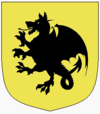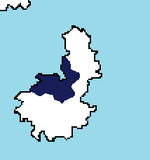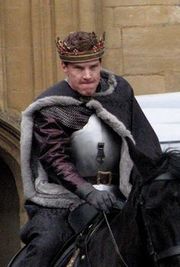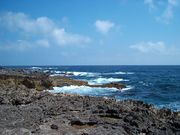Calbion
| Calbion Gwlad y Calbain (Calraeg) | |||
| |||
| Motto: Cyfiawnder a Chryfder "Justice and Strength" | |||
| Anthem: "Calon Lân" | |||
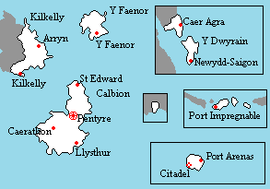
| |||
| Map versions | 15.0.5 - current | ||
| Capital | Pentyre | ||
| Largest city | Llysthur | ||
| Official language(s) | Calraeg (national language) Istvanistani (lingua franca) | ||
| Official religion(s) | Calbain Catologian Church | ||
| Demonym | Calbain | ||
| Adjective | Calbain | ||
| Government | Various, Decentralised Monarchy | ||
| • Prince of the Calbain | Jack II (last) | ||
| • Governor-General | Llywelyn Lewis (last) | ||
| • President of the Cynulliad Cenedlaethol | Huw Macklemore | ||
| Legislature | Cynulliad Cenedlaethol | ||
| Establishment | 1596 | ||
| Area | 362,880 km2 | ||
| Population | 3,581,000 (Population of the Calbain lands as of 1685) | ||
| Currency | Arian | ||
| Abbreviation | CAL | ||
| Driving side | right | ||
| Time zone(s) | CMT-3 | ||
| National animal | Black Dragon | ||
| National drink | Calbain Whisky | ||
Calbion (Calraeg: Gwlad y Calbain) was a sovereign island nation in the Great Western Sea. The nation occupied the Eastern part of the Jasonian islands (Ynysoedd Jasonaidd). The nation also had several colonies in Keltia. Calbion was a Monarchy, although it can be described as a 'Crowned Republic' because of the limited role of the Prince of the Calbain, who had a largely symbolic and unifying function. The last Prince of the Calbain was Jack II, although the title got usurped by the Vinandy regime during the Arcadian occupation.
The Calbain nation is one of the oldest civilisations on Micras, although often subjugated to political repression. In the year 1596, Calbion first gained an official status as an autonomous part of the Southbatavian empire. Following the Southbatavian transition towards the authoritarian empire of Jingdao, the Calbain autonomy was once again surpressed, which resulted in a short but bloody Revolt that saw the Calbain population decimated. Subsequently, Calbion was incoporated into the Brettish Commonwealth. Under the leadership of Llywelyn Lewis, the Governor-General of Calbion under Brettish rule, the identity of the Calbain people remained alive and the Calbain communities were restored. In recent history, Calbion was an autonomous province of Arcadia after the conquest of the islands by the Batavian Vinandy dynasty. The Vinandy's usurped Calbain titles, which created resentment and saw the politics of Calbion become divided into the "Realist" and the "Nationalist" fractions. Several historians pose that these internal division was one of the factors that lead to the collapse of Arcadia.
Calendar
Calbion uses the Calbain calendar, which has been synchronised to the Norton calendar. A year (blwyddyn) is divided into 15 months. The Calbain calendar differs from the original Norton calendar, in that it starts to count from the arrival of Jack Mounford (Jack I) and the establishment of Calbion as a sovereign political entity in the year 1596. Years before this moment are referred to with Cyn Dyfodiad (CD), years after this moment are Ôl Dyfodiad (ÔD).
History
Tribal Era
The earliest mentions of Calbain tribe in what now is Calbion comes from around 400 CD. The first mention of the word Calbain comes from Matbaic sources who speak of the tribe of the Calbi. Based upon archeological findings and oral history, it is most likely that the Calbain arrived on the island during the period in which the island was occupied by Aerlig. Linguists and historians have found Aerligan influences in Calraeg and early historical documents.
During the Matbaic period, Calbain kept to themselves, as appears to be the general strategy of the tribes. The Calbain were divided into three general groups, also known as the "hidden realms". These realms derived from important families and clans who often ruled the tribe in an autocratic fashion.
The three hidden realms were Dewlad, Morwlad and Penwlad. Dewlad, the "realm of the south" was ruled by the Arthur dynasty and was the nation most connected with the ruling classes. This proved to be both an advantage and a disadvantage. During the Matbaic period, Dewlad became occupied by Matbaic settlers who erradicated the Calbain culture. Due to intermarriage and the minority position of the Calbain, Dewlad lost to be an important Calbain region.
Morwlad, the "realm of the sea" wasn't as much as a centralised nation but rather a federation of cities founded by Calbain seafarers. The Morwyr, or seafarers, founded settlements in northern Calbion but also on Faenor and Nelaga island, as well as in southern Tapfer and Cibola.
Penwlad, the "headland", was the most important ancient Calbain nation and is regarded as the predecessor of Calbion. It is the only Calbain realm to survive the Matbaic era and as such, the culture of Penwlad has been the foundation for the Calbain culture as it is today. The capital of Penwlad was Pentyre, which still is the capital of Calbion. The realm was governed by the Llywelyn dynasty.
Maraguan Era
It was this society that the Maraguans met when they took over control of the island. The Maraguans, under the Maraguo Vrystaat and as part of Nelaga, had the desire to return to the culture of mythic land of Jasonia. To reach this goal, the Maraguans committed large-scale ethnic genocide on both Matbaians and Calbain.
The Calbain lived in close-knit communities during this period, waiting for a better time.
The north of Calbion was briefly occupied by Interland, remnants of Interlandian culture are still visible in, especially, St. Edward.
Southbatavian Era
This time came when Nelaga fell in 10 CD due to internal scheming, incompetent leadership and a fractured society. Famines had decimated the Maraguan people.
In Southbatavia, or Jingdao as it was known, it was a time of unrest. Juan, an army general, had tried to remove the Jingdaoese Emperor from power. The economic and political situation was dire. During that period, Jack Mounford, the leader of a Catologian order, united a group of impoverished people and sailed to unknown lands with a small fleet of Southbatavian refugees.
The island they landed was Calbion. Mounford stumbled upon a divided nation. The south was still very Maraguan, but the north was now under control of the Calbain. With the help of Jingdaoese forces, Mounford united the country and placed it under Southbatavian control. He himself was declared Count of Calbion. But that didn't prevent the Maraguan population to rise up against the, mainly Calbain, new government. This resulted in a bloody uprising that was dealt with accurately by the Calbain and Southbatavian forces. Subsequently, Jack Mounford recieved the title of Lord of Calbion. The reign of Jack Mounford saw large cultural development on the Island and the Calbain culture reached new hights. To reflect the ancient Calbain tradition, Jack Mounford was proclaimed Prince of the Calbain.
Several incidents occured however which created a schism between Calbion and the Southbatavian government. The first incident was the establishment of a rocket launching site. The Emperor wanted to build a rocketbase on the isle of Faenor, but the local residents objected strongly to these plans. Mounford was unable to prevent the building of this site and had to settle for an aircraft base which also included the rocket facility.
The second incident was the raid of a Natopian trading ship and of a Natopian holiday facility for homosexuals by the Calbain pirate Callaghan. The cruelty which the pirate displayed towards his victims led to a diplomatic crisis between Calbion and Natopia. This was only enlargened by the crash of a Natopian airplane on the Central Square in Pentyre immediately after.
Calbain Independence War
No longer wishing to submit to the rule of the despotic Empress Sisera, The Calbain rose up in a rebellion against Jingdao. A declaration of independence was drawn up and several Jingdaoese soldiers were killed. Sisera reacted by attacking Calbion in full scale, destroying large parts of the country and killing the large majority of the population. A desolate and post-apocalyptic landscape was all that remained of the once proud land.
In April of 2013, Calbion declared independence and was attacked by Southbatavia. Almost all cities were destroyed and the attack left an estimated survival rate of 3-4%.
Lost Era
Calbion was thrown back into the middle-ages, the technological level was near zero and the tribal society had returned, the Calbain still were a large group in this new society. The island later was briefly occupied by Maraguan revivalists who proposed to move the Calbain to the north. However, Calbain uprisings and protests brought an end to this plan. Soon after, the country fell into tribalism again.
Brettish Protectorate
Calbion joined the Commonwealth of the Brettish Isles as a protectorate. The Protectorate era was seen as a period of stability, in which Calbion recovered and returened to being a proud nation. Governor-General Llywelyn Lewis ruled Calbion in close association with the Brettish Government.
Independence
After some time, nationalist sentiments arose in Calbion. As the country became more and more developped, the Calbain population refused to adhere to Brettish rule and to, what was percieved to be, the everclosing Brettish dominance over the nation. Following protests, the leaders of Calbion and the Lord Protector of the Brettish Isles arranged a settlement that lead to Calbain independence. Governor-General Lewis became head of state until Jack II was proclaimed Prince in 145 ÔD.
Unification with Arcadia
Calbion was abandoned for a period, but revived by unification with Arcadia. The king of Arcadia became Prince of Calbion.
Politics
Prince of the Calbain
The Prince of the Calbain (Tywysog Calbain) was the head of state of Calbion and de facto head of government. The powers of the Prince of the Calbain have varied over time. During the time of the Hidden Realms and most certainly during the tribal era, the Prince of the Calbain ruled as an absolute monarch. The elected Princes during the Second Era often were regarded as primus inter pares among the high Lords of the land. Often, there has been no Prince of the Calbain at all, or only a weak person who held the title only as a symbolic feature, resembling the unity of the Calbain people.
Governor-General
The Governor-General (Llywodraethwr-Cyffredinol) was the official head of the High Council, the appointed government of Calbion. The Governor-General has usually been a strong position in Calbion. Sometimes the Governor-General served as primary advisor to the Prince of the Calbain, but often, the Governor-General ruled the country in name of the Prince.
High Council
The High Council (Gyngor Uchel) was the governmening council of Calbion. The council doesn't have a set number of members but generally has a membership of around ten. The way in which the High Councilmembers were appointed has varied over time. From appointment by the Prince to the appointment by the elected National Assembly.
National Assembly
The National Assembly (Cynulliad Cenedlaethol) was the place of gathering for the 'peasants' or the ordinary people. The Assembly was an elected assembly, its members are elected by the Calbain people in a system of first-past-the-post constituency voting. The largest party at the moment is the Party of Calbion (Plaid Calbinol) followed by the Calbain Alliance and the Conservative Party. Significant smaller parties are the Labour Party and the Maraguan Party.
Administrative Divisions
Calbion was a unitary state, divided into four administrative devisions. Three of the four devisions are Talaith (provinces) and one is a the Ffederasiwn Tiriogaethol (territorial federation) of Morwlad. The three provinces have limited self-government and are ultimately represented in the High Council by their respective Governors.
| Flag | Talaith | Capital | Population | Governor |
|---|---|---|---|---|
| Calbion Isle | Pentyre | 2,300,000 | Lord Robert Falton | |
| Kilkelly | Kilkelly | 630,000 | Lord Patrick Lewis | |
| Y Faenor | Y Faenor | 125,000 | Lord Owain Adelson |
| Flag | Ffederasiwn Tiriogaethol | Administrative Capital | Population | Governor |
|---|---|---|---|---|
| Morwlad | Caer Agra | 315,000 | Lord Thomas Roberts |
The Territorial Federation of Morwlad has its own assembly, the Territiorial Assembly, which has legislative powers on internal matters. As such, Morwlad is not represented in the National Assembly. The territories are governed by a viceroy, or rhaglaw. The four territories of Morwlad are as follows:
| Flag | Territory | Capital | Population | Rhaglaw |
|---|---|---|---|---|
| Port Moorland | Newydd Llysthur | 25,000 | Huw Rivers | |
| Port Impregnable | Port Impregnable | 34,000 | George Hardy | |
| Y Dwyrain | Caer Agra | 215,000 | Rhys Morstan | |
| Ynys Corrach | Port Arenas | 181,000 | Owain Veron |
Foreign relations
Calbion was a member of the Micras Treaty Organisation. The country has informal relations with Avalon, Natopia and Sangun. Calbion was a founding member of the Blackrock Pact, where it has strong relations with the Commonwealth of the Brettish Isles and Jingdao. As a consequence, Calbion became involved in the Euran War.
Military
The defense of Calbion was generally in the hands of the Order, a military organisation that evolved out of the Catologian Order headed by Jack Mounford. The Order is under command of the King as commander in chief. The Order serves as de facto armed forces of Calbion.
Besides the Order, Calbion had a navy and an air force. The Arwyr Airforce base on Y Faenor was the largest military base on Calbion.
Economy
Calbion was a nation of trade.
Geography and Nature
Calbion was an island nation with a diverse geography. The island of Calbion is mountainous and forrested in the north, while in the south and the west, green valleys and lowlands dominate the landscape. Y Faenor is a mountainous and barren island, with most of its population living in the South. Kilkelly has a more easy climate, it's landscape is characterised by green downs and high peaks in the far west. Northern Kilkelly is a famed holiday resort, for its pleasant climate. Morwlad is diverse in nature, Port Impregnable is a tropic island, with a warm climate. The Port Moorland colony has a harsh sea climate, while Y Dwyrain also is tropical and sunny, albeit subjected to heavy storms and rainfall.
Demographics
The largest ethnic group in Calbion are the Calbain, being almost 80% of the population. Calbion has significant Maraguan and Batavian minorities, respectively 10 and 8 percent.
Culture
Religion
There are several significant relgions in Calbion, the most predominant of which is Calbain Catologism. From the early days of the Calbain nation, polytheistic religions were common, unified in the old Calbain faith, featuring numerous gods. Even though this religion still has a cultural impact and even has followers today, the numer of actual believers in the old gods is estimated to be less than one percent of the population.
With the arival of Jack de Mounford on Calbion, Catologism spread rapidly. De Mounford himself was Grand Master of a Catologian order, known for a particular brand of fundamentalist Catologism which was the foundation for Calbain Catologism. Because of the position of Calbion, Calbain Catologism differs enourmously from classical Catologism and even more from Jingdaoese Catologism.
Smaller faiths such as Batavian Christianity, The Brettish Church and Solarism also have a presence in Calbion.
Sports
The two most popular sports in Calbion are Rugby and Football. Calbion's national teams are respected all across Micras. Calbion is known as the founding nation of the Micras Rugby Union.
Football in Calbion is controlled by the Calbion Football Association (Calbion Cymdeithas Bêl-droed). Calbion has one professional football league, the Gynghrair Gyntaf and a national team that participates in major international competitions.

